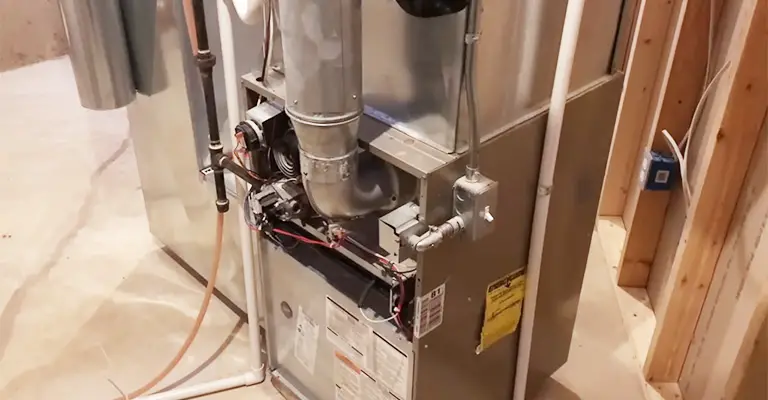When winter’s chill sets in, the last thing you want is for your furnace to start blowing cold air instead of providing the comforting warmth you rely on.
This unexpected issue can be inconvenient and uncomfortable, leaving you puzzled about what could be causing it.
Fortunately, there are several potential reasons behind a furnace blowing cold air, and in this guide, we will explore them and provide troubleshooting steps to help you resolve the problem.
Whether it’s a minor fix or requires professional assistance, understanding the possible causes can aid you in finding a solution and restoring your furnace’s proper functionality.
Your furnace may not be blowing hot air for various reasons, but often the problem is in setting the furnace to “on” instead of “auto”. This means the fan will run continuously regardless of whether the furnace is operating.
When the system is functioning properly, resetting the thermostat to auto should resolve your problem.
There are times, however, when furnace service is needed if the problem is more complicated. You can schedule furnace repair assistance from local Carrier HVAC experts if need be.
Why Is My Furnace Blowing Cold Air?
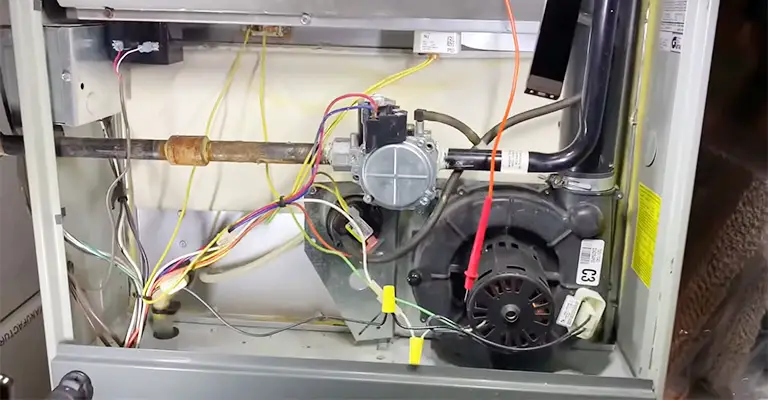
Many people put off furnace maintenance until they realize there is a problem during the winter. Here are a few tips you can follow to help you find and potentially fix the cause of your furnace blowing cold air.
A Clogged Or Dirty Air Filter
You may have clogged or dirty air filters when your furnace blows cold air. Ensure it is clean by removing the air filter and inspecting it.
Unless it’s clogged by dust, you could try blowing it off with compressed air, washing it in warm water with mild soap, or simply getting a new one.
At the very least, the air filter should be changed twice a year. The first time in the spring before you turn on the AC for summer, and the second before temperatures dip in the fall before you turn on the furnace constantly.
Thermostat Problems
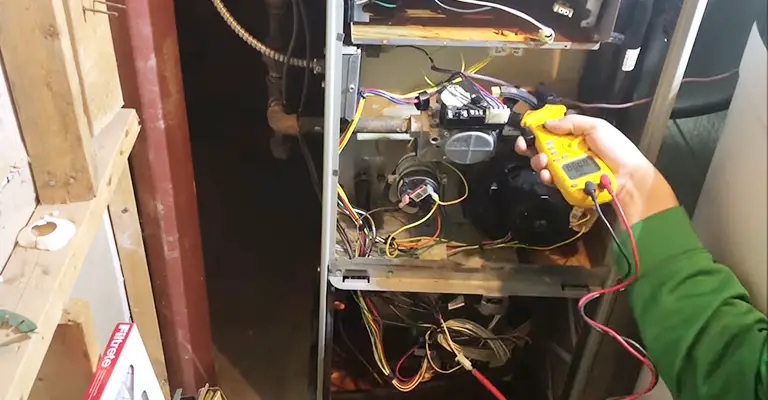
Checking your heating system can begin with checking your thermostat since there can be several problems.
1. Battery is Low
Batteries can run low in thermostats and cause them to stop working. No problems are present in your home’s heating or cooling system or wiring.
This is just a dead or waning battery. In the same way that a battery starts to deteriorate, so does the thermostat function. It is recommended that you replace thermostat batteries once a year.
2. The Thermostat Keeps Getting Altered
Because people don’t want to make their families uncomfortable, they don’t change their thermostat settings.
The only exception is if you live with other people, you may want to keep an eye on who is pushing the thermostat buttons. To prevent kids from getting at the thermostat, mount it high enough on the wall.
3. Fan is on the Wrong Setting
Your furnace’s fan runs in response to a thermostat request for heat. It can be configured so that it only runs when necessary.
It is called “auto” mode and prevents your fan from blowing cold air when the correct temperature is reached. Additionally, you will save money on your heating bills. It’s common for homeowners to set their thermostats to “fan” rather than “auto.”
The Heater Hasn’t Warmed Up Yet
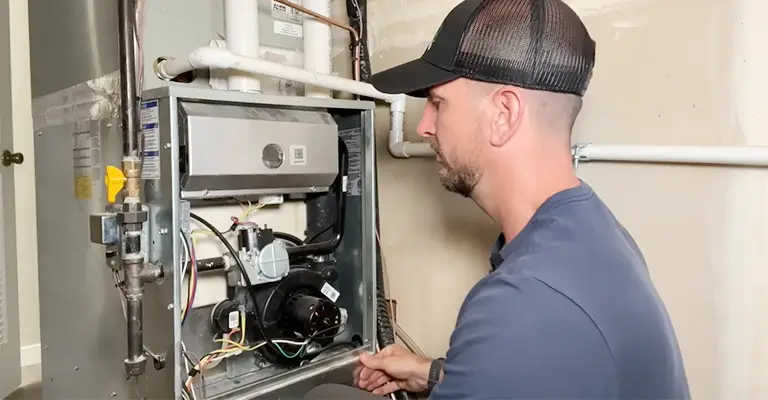
If your furnace kicks on, but no airflow is coming out, or if your heater is blowing cold air, no matter what you do, you’ll find out why. You may immediately think you need to call your HVAC technician, but maybe your furnace is functioning normally.
In many furnaces, the fan limit switch regulates how much heat the furnace adds to the air before the blower sends it out through the ducting.
Your furnace’s owner’s manual should indicate whether there should be a blower delay after the gas burner kicks on. You may need to contact your HVAC contractor if, after a few minutes, your furnace is still blowing cold air.
Flame Sensor Issues
A dirty or worn flame sensor cannot detect the flame correctly and will cause the furnace to shut off.
Performance is reduced, and energy costs are increased as a result. Cleaning your flame sensor may be possible, but if you are uncertain, call a professional. You may need to hire experts to install a new sensor.
Burner Issues
Designed for very high temperatures, burners burn fuel very quickly. As they are used and become clogged with dust and other debris, they may become clogged over time.
It is important to check the burners in your furnace to see if they are burning out frequently after being owned for a number of years.
Pilot Light Isn’t On
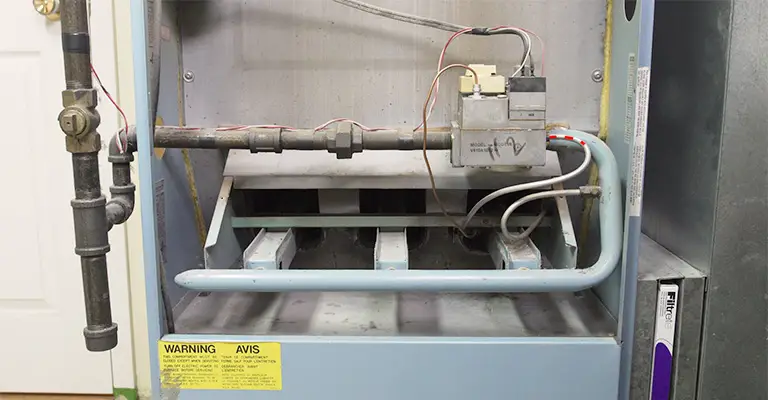
An igniter, or pilot light, ignites the gas coming through your furnace. If your furnace has a pilot light, the gas will be ignited by electricity if it does not have a pilot light. Inspect the pilot light for a burnt-out filament. In that case, you will need to relight the stove and reset the thermostat.
Too Many Closed Supply Vents Caused The Furnace To Overheat
Your furnace may have too many closed vents if your room is too cold or hot, you notice inconsistent temperatures in different parts of your house, you see the actual room temperature is different from your thermostat’s setting, or you notice that the furnace turns on and off often (short cycling).
Some homeowners close the heat vents in unused rooms during the winter. In the case of closed vents, the furnace might cycle more frequently, resulting in lower overall comfort in the house and a shorter furnace lifespan.
Check your heat vents and see if they need to be opened. Then try closing fewer vents this time if it does if you still want to do that.
The problem may not be fixed even after you open all the vents; you may wish to consult an HVAC professional to evaluate your heating system and duct work.
Leaking Ducts
The most common culprit for leaks is old or damaged ductwork that is improperly sealed against leaks inside or outside the home. In reality, leaks can occur at almost any point in the HVAC system.
Leaky ductwork not only results in reduced comfort but also raises utility bills because the amount of heat lost is increased.
A Problem With The Fuel Source
Your furnace might not function because you’re out of fuel. The following can help you decide whether to call a professional:
An example of a circuit breaker might be a fuse box. You should replace thrown fuses and tripped circuit breakers with new ones of the correct amperage when you see them.
To check whether the gas supply line is leaking or crimped. Inspect the tank to see if there is any oil left.
There Is A Problem With The Computerized Controls
An electronic control board runs most modern furnaces, following a specific sequence of operations.
However, It is possible that there is something wrong with your computer-controlled furnace if you wonder why your heater is blowing cold air, why the temperature keeps fluctuating, or why it isn’t operating as it usually does.
If a heater is running, there may be a problem with your furnace’s control board, but the temperatures indoors are excessively hot or cold.
There is also a sign when the usual sequence of operations seems to be altered. Do you hear the igniter start-up? What sounds do you hear when the gas burner ignites?
What if the blower fan continues to run for a long time, even after the heating system has shut off?
If you remove the cabinet door and see blinking LED lights on the board, there may also be an issue. There are many gas and electric furnaces with built-in diagnostics, which blink in distinct patterns to indicate something is wrong.
It is best to contact your local Carrier expert for assistance if your control board fails. The HVAC dealer can provide you with more information about the blinking LEDs on the control board before calling for service.
Clog In The Condensate Drain Line
You can drain condensate via the condensate drain line attached to the base of your furnace and into a drain pan.
When this drain line becomes clogged with debris, your furnace won’t be able to drain its excess moisture. Having an HVAC technician clear the drain line for you would be best.
High Limit Switch Failed
The high-limit switches shut off the power to the compressor to prevent it from overheating.
There can be a blockage in the line or too much heat from the compressor, causing this problem. Your furnace could experience difficulties if your high-limit switch isn’t working properly.
It is important to check your air filter periodically and to clean or replace it if necessary. Consequently, the furnace will shut down because the fan limit switch is tripped by a clogged filter that prevents airflow to the heat exchanger.
An HVAC technician can assist you if the high-limit switch stops working on your furnace. Long-term neglect of this problem may result in more serious consequences.
Final Words
A furnace is an expensive and complex machine that has the potential to fail at any time, putting your home at risk. You should never play around with gas or electricity unless you know what you’re doing.
You will find it uncomfortable if your furnace blows cold air, regardless of its cause. Some solutions are easily solved with minimal technical skills, such as properly cleaning the air filter or configuring the thermostat.
It is essential to keep your furnace working at peak levels, so regularly schedule annual maintenance and tune-ups. You’ll be able to keep your furnace safe and reliable with the help of a qualified HVAC technician.

